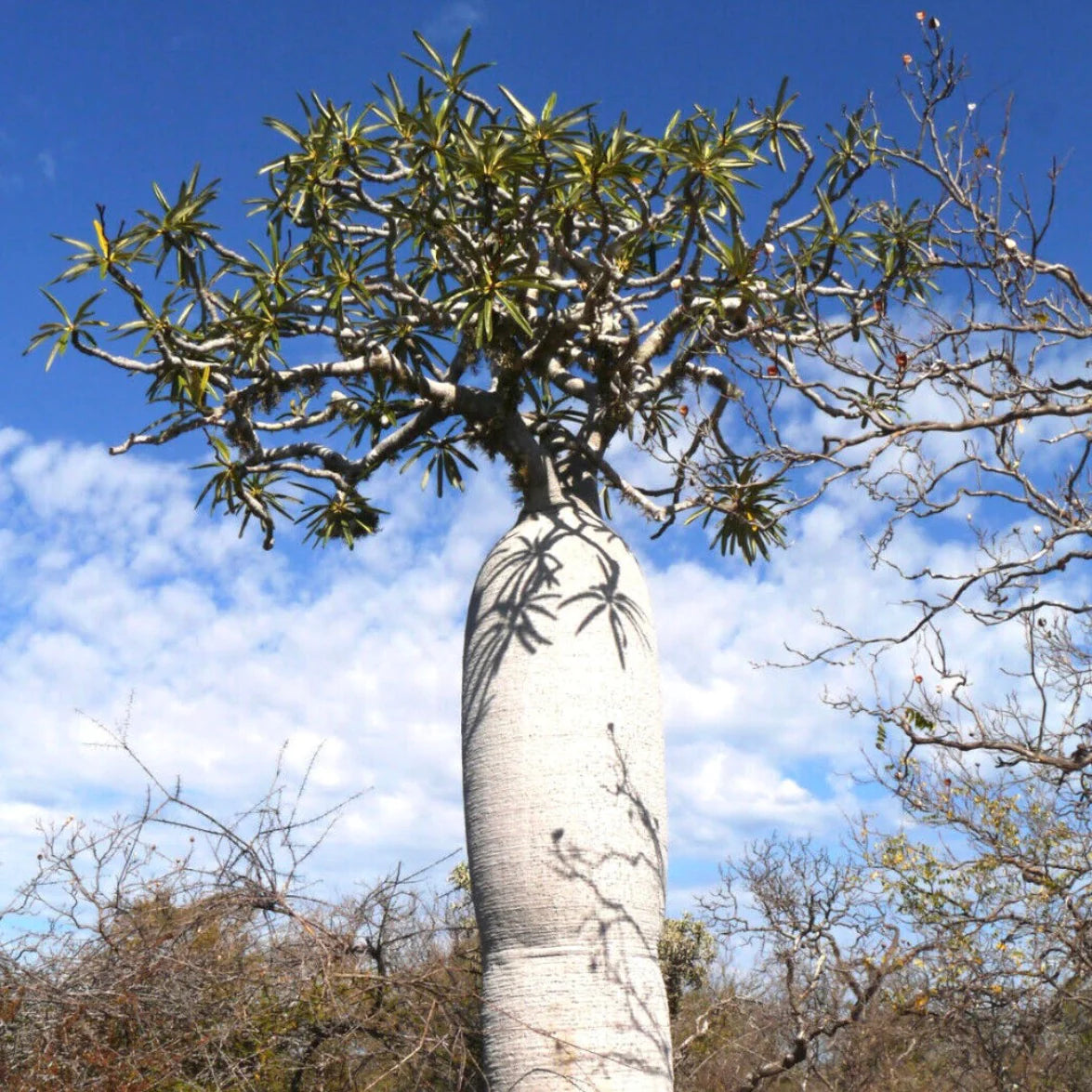Pachypodium geayi, also known as the "Madagascar Palm," is a striking succulent plant native to Madagascar. Here's a description of its characteristics:
-
Appearance: Pachypodium geayi typically grows as a small tree or shrub, reaching heights of up to 4 meters (13 feet) in its natural habitat. It has a thick, swollen trunk covered with sharp spines or thorns arranged in a spiral pattern. The trunk is topped with a cluster of long, narrow leaves that grow in a rosette formation.
-
Leaves: The leaves of Pachypodium geayi are typically green or bluish-green in color and can measure up to 30 cm (12 inches) in length. They are succulent and may have a slightly waxy texture.
-
Flowers: In late spring to early summer, Pachypodium geayi produces stunning white or creamy-yellow flowers with a tubular shape. These flowers appear in clusters at the ends of the branches and are often fragrant, attracting pollinators such as bees and butterflies.
-
Habitat: Pachypodium geayi is native to the arid regions of Madagascar, where it grows in rocky, well-draining soils. It is adapted to hot, dry conditions and is drought-tolerant once established.
Cultivation from Seeds:
Growing Pachypodium geayi from seeds can be a rewarding but challenging process due to its slow growth rate and specific habitat requirements. Here are some cultivation tips:
-
Seed Source: Obtain seeds from reputable suppliers specializing in succulent plants or botanical gardens with collections of Madagascar flora.
-
Seed Preparation: Before planting, soak the seeds in warm water for 24-48 hours to soften the seed coat and improve germination rates. Some growers also scarify the seeds lightly with sandpaper to further enhance germination.
-
Growing Medium: Use a well-draining potting mix suitable for succulents. A mix of coarse sand, perlite, and peat moss or coconut coir works well. Ensure the growing medium is sterile to prevent the risk of fungal diseases.
-
Planting: Plant the seeds in small pots or seed trays filled with the prepared growing medium. Sow the seeds shallowly, covering them with a thin layer of soil.
-
Light and Temperature: Provide bright, indirect sunlight for the seedlings. Pachypodium geayi thrives in warm temperatures between 70°F to 85°F (21°C to 29°C) during the growing season. Protect young seedlings from intense midday sun to prevent sunburn.
-
Watering: Keep the soil lightly moist but not waterlogged during the germination period. Once the seedlings establish roots, gradually reduce watering to mimic the plant's natural drought-resistant adaptation. Allow the soil to dry out between waterings.
-
Transplanting: Transplant the seedlings into larger pots as they outgrow their containers. Handle the seedlings with care, as they have delicate roots. Use a similar well-draining potting mix for the new containers.
-
Maintenance: Fertilize the seedlings sparingly with a balanced, diluted fertilizer during the growing season to promote healthy growth. Prune any dead or damaged growth as needed to maintain plant health and shape.
-
Pest and Disease Control: Regularly check the plants for signs of insect infestations, such as aphids or mealybugs. Treat infestations promptly with insecticidal soap or neem oil. Ensure good air circulation around the plants to prevent fungal diseases.
-
Patience: Growing Pachypodium geayi from seeds requires patience, as the plants have a slow growth rate. It may take several years for the seedlings to reach maturity and develop into robust specimens.
By following these cultivation tips and providing the appropriate care, you can successfully grow Pachypodium geayi from seeds and enjoy its unique beauty in your collection of succulent plants.


